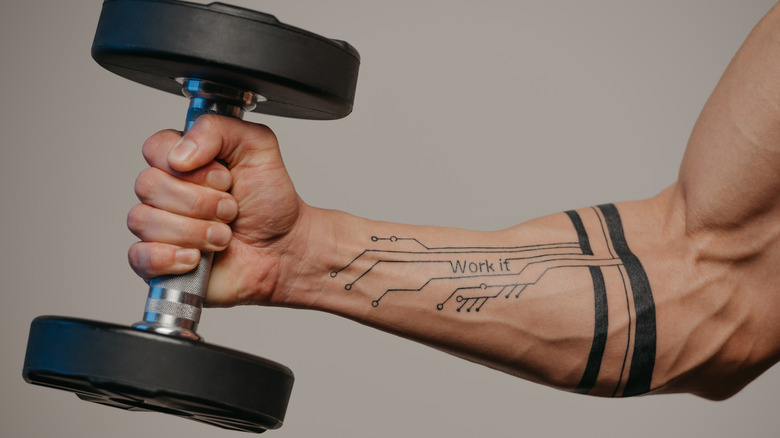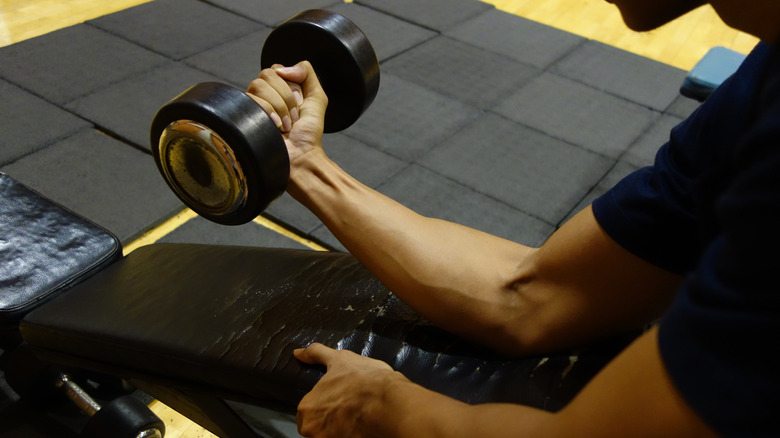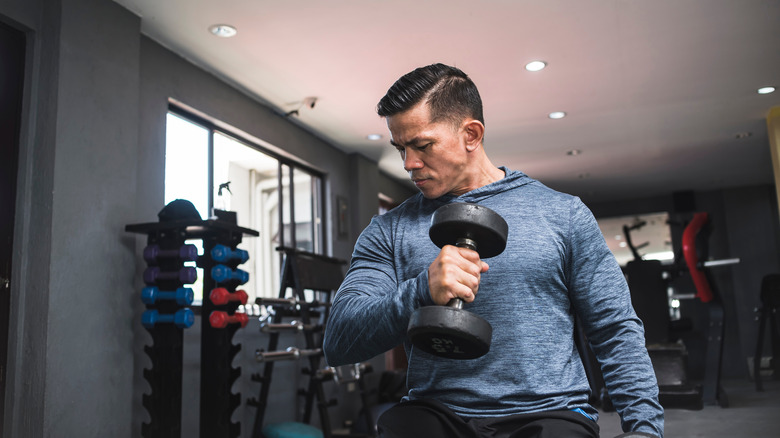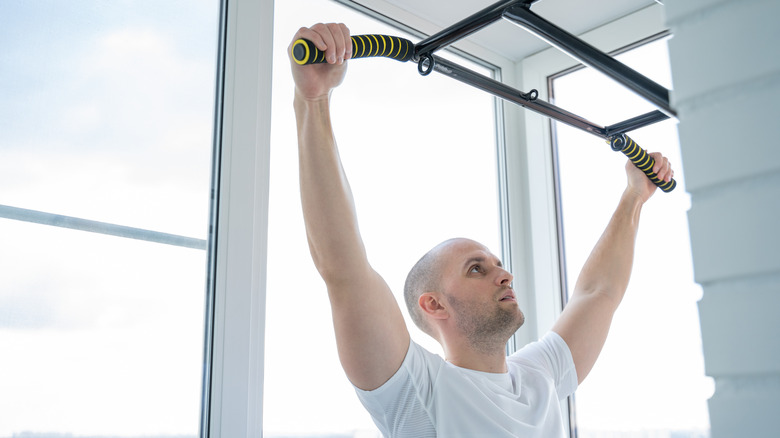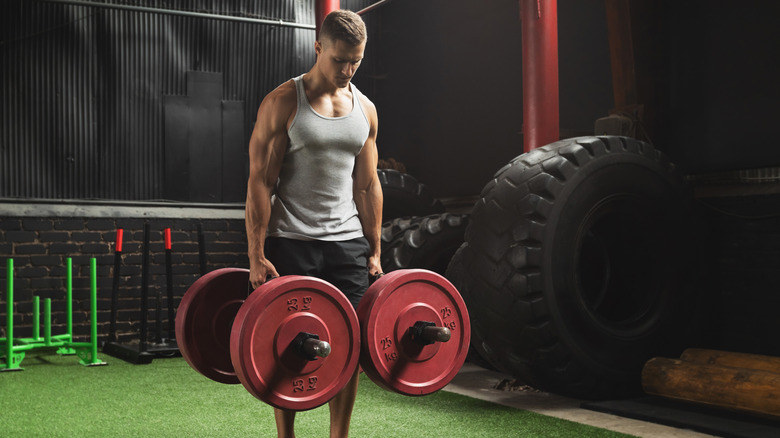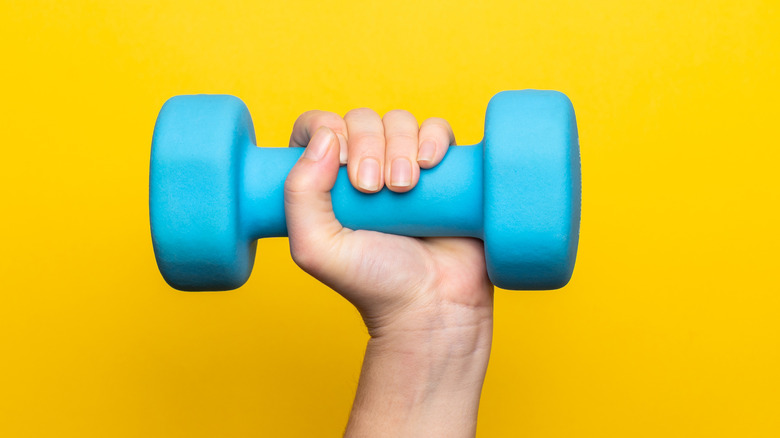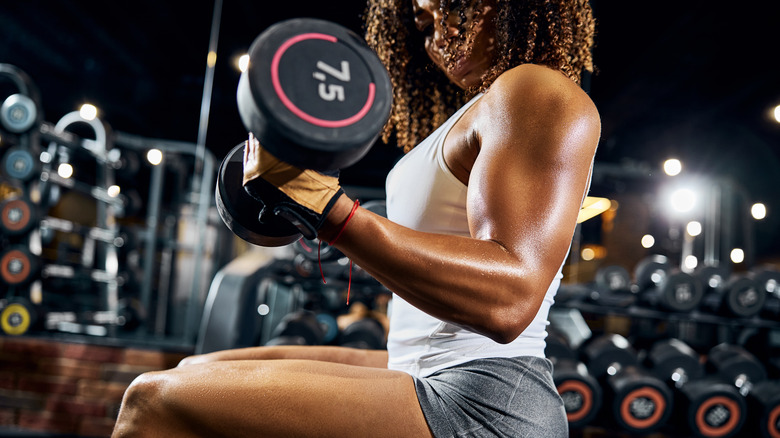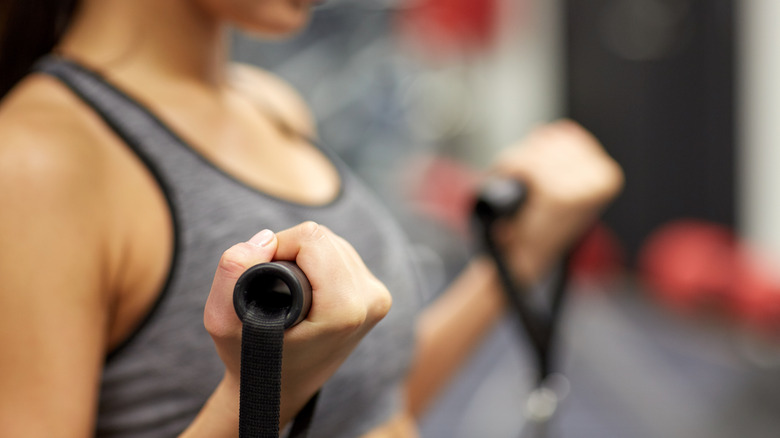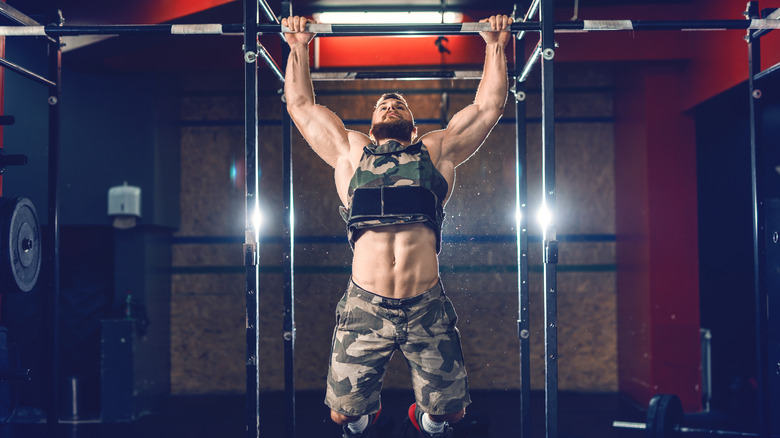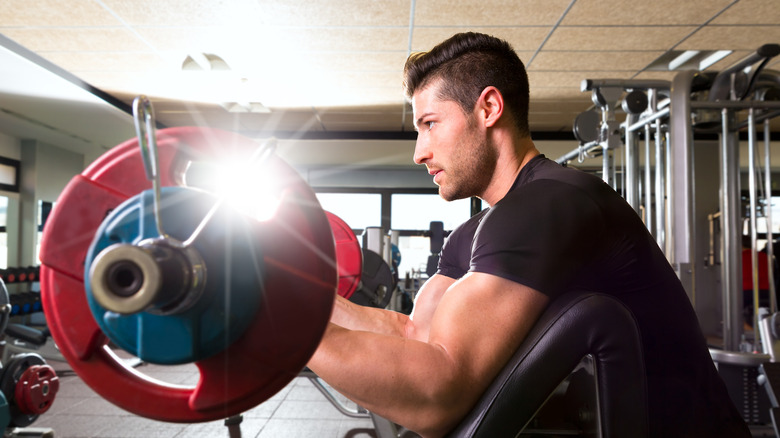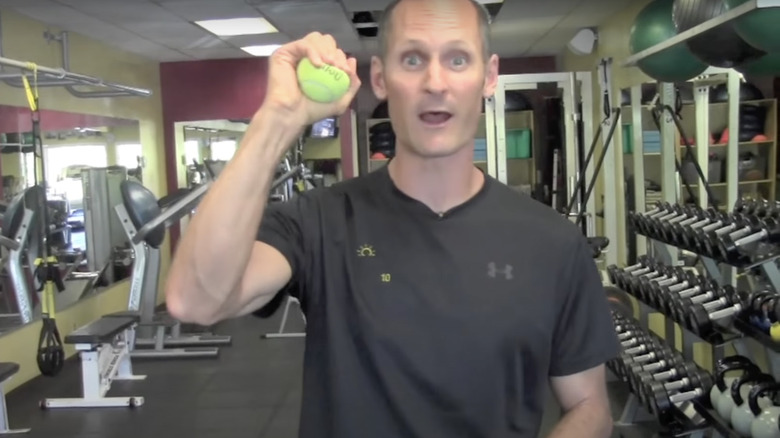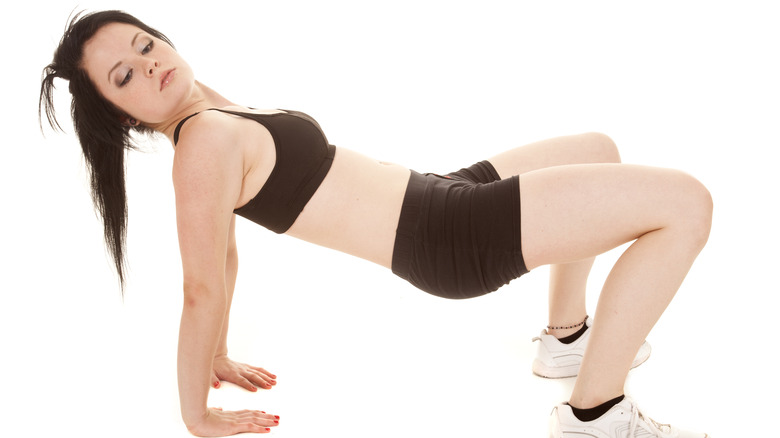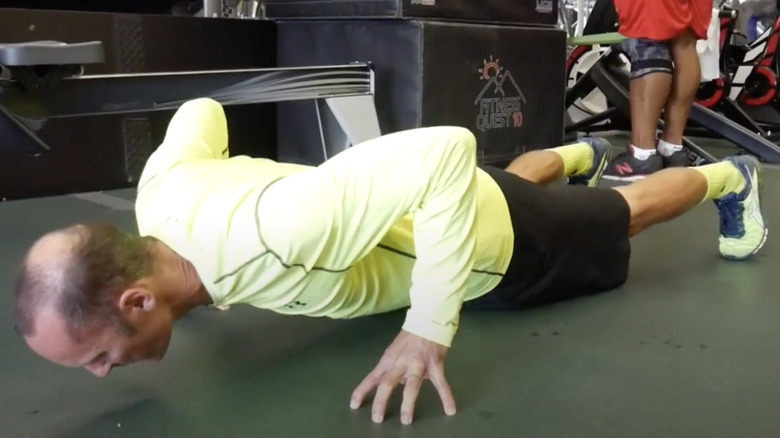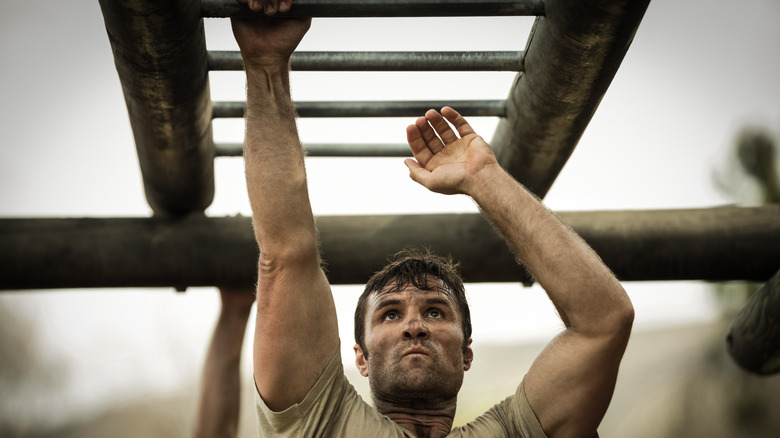The Best Exercises You Can Do To Strengthen Your Forearms
When you think about working out your arms, we're willing to bet your mind immediately goes to the upper part: Swollen biceps, ripped triceps, and bulging shoulders. But let's take a second to give a little love to our forearms.
Composed of a surprising amount of muscles, your forearms are essentially the front line of your day-to-day tasks — from carrying items to unscrewing stiff bottle tops — and are involved in a large number of exercise activities (per the National Federation of Professional Trainers). Ensuring that your forearms are well-tended during a workout will not only help you complete functional tasks with more ease, but will also reduce the risk of potential injury or strain to your hands or wrists.
But given that the forearms aren't most people's priorities when they're working out, they can often be forgotten about. And when they're not forgotten about, figuring out how to exercise them properly might be a little tricky. Luckily though, there are a huge amount of exercises that hit your forearms, both directly and indirectly, and here at Health Digest, we wanted to make sure you knew them all. So let's take a look.
Wrist curls
Look no further if you're looking for an exercise that'll blast your forearms. Wrist curls are one of the most effective exercises to build both forearm and wrist strength, and all they take are a pair of dumbbells and a flat surface to rest your forearms on.
Grab a pair of dumbbells and place your arms across a bench or surface in front of you, with your palms facing skyward (via Bodybuilding.com). Make sure that your back is flat and relaxed, your arms are shoulder-width apart, and your shoulders aren't hunched forward. Gently roll your wrists up and towards you, bringing the weights in as you exhale (think of it as a sort of mini-bicep curl, except you're trying to keep the motion in your wrist, and not moving your forearm). As you breathe in, roll your wrists down, and then return them to the starting position.
If you're new to wrist curls, bear in mind that the wrist is a delicate part of the body, so it's really important not to overload it with weight. Ensure that your movements up and down are slow and controlled, too, and not jerky or aggressive, as this can place unnecessary strain on the wrist area.
Dumbbell hammer curls
Gaining strong, visible biceps is an exercise goal for a huge amount of people. But did you know that while doing that, you can also make sure your forearms are being tended to as well? With a dumbbell hammer curl, you can effectively target your forearms to build mass and grip strength, while also engaging your biceps, in an exercise that does double-duty (per Barbend).
To perform a dumbbell hammer curl, stand in a regular stance, your feet facing forward and roughly shoulder-width apart, avoiding locking your knees (via Coach Magazine). Hold a dumbbell in each hand, with your palms facing inward, to the outside of each thigh. Curl one of the dumbbells up towards your upper body, ensuring that your elbow doesn't flare outward, and squeeze your bicep at the top of the lift. Then, lower your dumbbell down to the starting position, while simultaneously performing the same movement on the other side. If you want to focus on your muscles even more, you can perform this one arm at a time, keeping your other arm free. Make sure that you're breathing regularly throughout the movement, to avoid generating tension in your body.
Pull-ups
Ah, the pull-up. Has there ever been an exercise so loved by fitness experts, yet so loathed by amateur exercisers? But whether you adore it or despise it, there's no denying that the pull-up is great for your body — and your forearms.
While the pull-up is primarily a back exercise, the forearms are also engaged, thanks to the gripping action on the bar above, says Critical Body. And depending on the type of grip you use, you can target different parts of your forearm, with your forearm flexors activated through an underhand grip, and brachioradialis and extensors taking on more of the load in an overhand position.
Doing a pull-up can be tricky if you're new to it, so make sure that your form is as good as can be. Hold the bar above you at shoulder-width or on the handles provided, with your hands either facing away or toward you (per Coach Magazine), depending on which part of the forearm you want to target. Shift your weight so you're hanging off the bar, and keeping your core and back activated, pull yourself up, so that your chin goes over the bar. Lower down, and repeat. If you're having trouble completing a pull-up — and we would understand, they're hard! — build up your stamina by doing wide-grip lat pull-downs or eccentric pull-ups, says former Royal Marines physical training instructor Sean Lerwill.
Farmer's carry
As far as forearm exercises go, they don't get much simpler than a farmer's carry. Also known as a farmer's walk, this basic yet challenging move will fire up your forearms effectively, while simultaneously working your core. And the best part is, all you need are some weights (either dumbbells or kettlebells will do) and a bit of space.
Begin by standing in a regular position, facing forward, with a weight on each side of your body, on the floor (per Healthline). Grab the weights, making sure to come down in a squat to do so, pick them up, and then walk forward. Make sure that you keep your back straight and your shoulders are down and back, advises Freeletics training specialist Thomas Valda (via GQ). If you're new to the exercise, it's useful to start small and build up, with a lower weight and a shorter distance walked. Once you've started to build up those forearms of steel, you can make things heavier and longer.
Reverse wrist curls
Wrist curls are a staple in a forearm workout, but as with everything in life, it's good to flip things now and again. The reason being, if you're doing only regular wrist curls, you're going to end up overtraining one part of your forearm and ignoring the other side, says Critical Body. With reverse wrist curls, however, you're targeting the extensor muscles in the posterior section of your forearm (the top of your forearm, for laymen like us), which operate the upward motion of your wrist and hand.
To do a reverse wrist curl, find yourself a bench or flat surface, or in a pinch, use your knees. Place your forearms palm-down on this surface, holding a dumbbell in each hand, and allow the dumbbells to hang down over the edge. Slowly curl your hand up, so that the back of your hand is coming towards your body, activating through the top of the forearm as you do so. Squeeze slightly at the top, and then return to your starting position, repeating 15-20 times for several sets. Make sure that when you're lifting the weight your hand is coming past your forearm, not stopping when it's halfway up, to get the best pump. And crucially, don't try and overload yourself with weight — these are small muscles, so don't run before you can walk.
Zottman curl
Okay, so we are very much here for a workout move that sounds like a Marvel character. But as well as having an unparalleled name, the Zottman curl can also provide a pretty unparalleled activation to both your biceps and your forearms. The secret lies in the twist: Midway through a Zottman curl, the arm is rotated, which increases the targeting to your forearm muscles and your upper arm, says fitness director for Men's Health B. J. Gaddour (via Men's Health).
To do the Zottman curl, begin by standing in a regular biceps curl position. Lift the dumbbells, as though you were doing a normal biceps curl, pausing briefly at the top of the movement. Then, when you start to lower the weights, around halfway down, twist your arm into an underhand position, continuing to move downward as you do so. Give yourself between 3-5 seconds to lower the weights slowly back down to your sides, advises Gaddour. Repeat the movement between 10 and 15 times, for as many sets as you wish. And, if you want to really blast those forearms, apply fat grips to your dumbbells. This increases the level that you have to grip the weights and makes the workout even more effective.
Behind-the-back cable curl
You might ordinarily associate gym machines as being effective for targeting the larger muscles in our body — the leg press for your thighs, the fly machine for your chest, and so on. But gym equipment can be used to fire up your smaller muscles, too, and by using a cable machine, you can bring your forearms to the party. A behind-the-back cable curl, performed with a cable machine, will work out your forearm flexors and brachioradialis muscle, while also focusing on your bicep and brachialis muscles (via Critical Body).
Performing the move is a breeze, too. Locate a low pulley on your cable machine, and attach a stirrup or D-handle. Stand next to the handle, facing away from the machine, and grab it, stepping forward so that your hand is behind you. Make sure you take a good step, as standing too close to the machine will limit the exercise's efficacy. Then, using a bicep curl motion, pull the handle up, engaging your bicep at the top of the range of motion. Slowly return your hand to its starting position, and repeat for 10 to 15 reps, for as many sets as you require.
Dead hangs
Okay, folks, they don't get much more simple than this. We're very pleased to report that if you're looking to build your forearms, the only thing you have to do is, quite literally, hang out. Okay, so it's not quite chilling on the couch, but hanging in a static position (better known as a dead hang) will allow you to develop forearm and grip strength, through the constant motion of holding on to a pull-up bar using your body weight (per Healthline).
This move is as fundamental as they come, but as with all exercises, there's a right and a wrong way to do it, so allow us to talk you through it. Stand below a bar and grip it in an overhand position, and then shift your body weight off the ground so that you're hanging off the bar. Ensure that there's a gentle bend in your elbows. Then, you just need to hang there, for as long as you can. Make sure that your core remains engaged throughout, and that your shoulders aren't bunching up around your ears — pull your shoulder blades down and back as you hang.
Thumbless overhand preacher curls
We realize that the name of this exercise might sound a little daunting (not least because it implies that you need to remove your thumbs to do it — don't worry, we assure you that no digits will be harmed while performing it!). But trust us, it's not only simple, but also great for your forearms.
Although preacher curls primarily serve to build your biceps, the thumbless overhand variation will also add resistance to your forearms, improving strength and grip strength, says Coach Magazine. If you have an EZ bar handy, you might find it easier to use for this variation, but a regular barbell or a pair of dumbbells will also do the trick.
To begin, position yourself as you would if you were doing a regular preacher curl, with your upper arms resting on the pad in front of you. But instead of gripping your weight underhand as normal, hold it in an overhand position, and don't wrap your thumb around the bar. Using just your four fingers to grip the bar, pull the bar up in a curl until it's at its highest point. Squeeze the bar at the top of the movement, and then return it to its starting position.
Deadlift holds
Deadlifts are hard to beat when it comes to strength moves: As well as blasting your quads, glutes, and hamstrings, the exercise will also strengthen muscles across the entire length of your back, your traps, and activate your core (per Women's Health Magazine). And as it turns out, isolating one specific part of a deadlift in a deadlift hold can result in a pretty boss forearm workout, too.
To do deadlift holds, things needn't be complicated. Simply stand in front of your weight bar as you would if you were about to perform a normal deadlift, and grab the bar in an overhand grip (via GQ). Squat down to grab the bar, and lift it up — and then, hold. Try and keep the bar in position for as long as possible before returning it to the ground. Ideally, you want to perform 3-4 sets of at least 30 seconds per hold, resting for around a minute between each. The overhand grip that you adopt might be trickier than doing the move underhand, but it'll fire up your forearms way more by doing so.
Tennis ball hand clench
You don't need to learn any fancy moves or buy any specialist equipment to work out your forearms. The beauty of exercising this body part is that it can get a serious pump by using everyday moves and everyday objects.
A simple clenching exercise, done using a tennis ball, will see rapid improvements to your grip strength, which not only assists you in performing various functional actions in your day-to-day life more easily, but is also a solid general indicator of good health. In fact, did you know that, according to research published in The Lancet, better grip stretch was associated with greater longevity? We didn't, but now that we do, we're feverishly searching for tennis balls online to do this move.
Grab a tennis ball with one hand, and hold it without using your thumb, with your elbow bent (via Men's Health). Using the four fingers that are gripping the ball, squeeze it repeatedly. You can do this as many times as you can, but ideally, you want to be performing 50-100 clenches a day to really activate and improve your grip strength.
Crab walk
Who would've thought that working out your forearms could be so much fun? While you might not associate a crab walk with forearm strength, it's an effective and enjoyable way to build endurance and power in your lower arms, says The Healthy. It's also a great way to do so while also targeting a frankly huge amount of other muscles, including your shoulders, glutes, back, abs, hamstrings, and triceps. We are well and truly here for an exercise that covers that many bases while remaining joyful to perform.
You probably remember the basics of a crab walk from doing it as a kid, but in case you need a little reminder: Sit on the floor with your legs bent in front of you, feet flat on the ground, and your palms behind you, fingers facing forward. Using your arms and legs, push your hips off the ground, activating your central muscles (the core and glutes) as you do so. Start to walk backward using your hands and feet, until you've traveled around 10 to 15 feet or so, and then repeat the motion in the opposite direction. Repeat, going backward and forward, for up to 60 seconds before taking a break.
Fingertip push-ups
The humble push-up is a move that, to be blunt, has a pretty wild amount of variations for such a seemingly simple exercise. And one such variation, the fingertip push-up, takes the focus to an entirely new place: Your forearms. This challenging take on push-ups helps to blast your forearm muscles effectively — but be warned that unless you're already a push-up pro, it might be beneficial to skip trying to do these push-ups on the floor straight away (and use elevation intead).
Grab an exercise bench and kneel in front of it, placing all five fingertips of each hand on the bench at shoulder width. Bring your weight so that it's supported by your fingertips, and then lower your chest to the bench, in a push-up motion, until your elbows are at a 90-degree angle. Push yourself back up to your starting position, and repeat for 8 to 12 reps, for as many sets as you desire. Not hard enough? Try performing the exercise with your legs fully extended, on your toes, instead of using your knees to support — and if you really wanna challenge yourself, do them on the floor.
Monkey bars
Okay, now we're talking. We're willing to bet pretty good money that when you were swinging around on monkey bars as a kid, you weren't thinking about the impact it might have on your forearm strength. But as an adult, it may well interest you to know that training using monkey bars is an effective and very fun way to build up forearm muscles. The grip that you have to utilize to hold each bar serves to increase strength, and the best part is that you can do this in your local park. (Once you've let the kids have their turn, of course.)
It's useful to remember that for monkey bar training to be effective, ideally, you'll treat it as you would any other gym exercise, with sets and reps. Try starting by swinging from bar to bar 10 times or so, resting between each set briefly for a total of five sets, says GQ. If you find that that's not challenging enough, add on more distance, or increase your rep count. You'll get stronger forearms, and you'll have a blast doing it — what more could you want?

